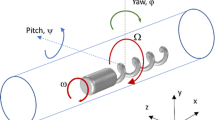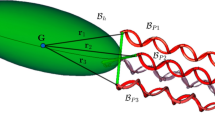Abstract
This study reports experimental and numerical model results on swimming of microswimmers inside circular channels. Designed to mimic the swimming behavior of biological organisms at low Reynolds number flows, a number of microswimmers are manufactured utilizing a 3D printer and consist of a helical tail and a body that encapsulates a small magnet. The swimming motion results from the synchronized rotation of the artificial swimmer with the rotating magnetic field induced by three electromagnetic-coil pairs. In order to obtain linear and angular velocities and to analyze the motion of the microswimmer, a computational model is developed to obtain swimmer velocities from the solutions of three-dimensional steady Stokes equations which govern the flow around the swimmers inside the channel. Experiments and numerical simulations are carried out for a number of configurations with different geometric parameters and flow rates in the channel filled with glycerol. Numerical results agree well with experimentally measured average velocities of swimmers. Results describe the influence of the flow rate, length of the tail, diameter of the channel, and the direction of the rotation of the swimmer on the velocity and trajectories of microswimmers.












Similar content being viewed by others
References
Acemoglu A, Yesilyurt S (2014) Effects of geometric parameters on swimming of micro organisms with single helical flagellum in circular channels. Biophys J 106(7):1537–1547
Berg HC, Turner L (1990) Chemotaxis of bacteria in glass capillary arrays. Escherichia coli, motility, microchannel plate, and light scattering. Biophys J 58(4):919–930
Berke AP, Turner L, Berg HC, Lauga E (2008) Hydrodynamic attraction of swimming microorganisms by surfaces. Phys Rev Lett 101(3):038102
Biondi SA, Quinn JA, Goldfine H (1998) Random motility of swimming bacteria in restricted geometries. AIChE J 44(8):1923–1929
Chacón R (2013) Chaotic dynamics of a microswimmer in Poiseuille flow. Phys Rev E 88(5):052905
COMSOL 2014 (COMSOL Inc., Burlington)
Costanzo A, Di Leonardo R, Ruocco G, Angelani L (2012) Transport of self-propelling bacteria in micro-channel flow. J Phys Condens Matter 24(6):065101
Dreyfus R, Baudry J, Roper ML, Fermigier M, Stone HA, Bibette J (2005) Microscopic artificial swimmers. Nature 437(7060):862–868
Ghosh A, Fischer P (2009) Controlled propulsion of artificial magnetic nanostructured propellers. Nano Lett 9(6):2243–2245
Gray J, Hancock GJ (1955) The propulsion of sea-urchin spermatozoa. J Exp Biol 32(4):802–814
Happel J, Brenner H (eds) (1983) Low Reynolds number hydrodynamics: with special applications to particulate media, vol 1. Springer
Higdon JJL (1979) The hydrodynamics of flagellar propulsion: helical waves. J Fluid Mech 94(02):331–351
Keaveny EE, Maxey MR (2008) Spiral swimming of an artificial micro-swimmer. J Fluid Mech 598:293–319
Lauga E, DiLuzio WR, Whitesides GM, Stone HA (2006) Swimming in circles: motion of bacteria near solid boundaries. Biophys J 90(2):400–412
Lighthill J (1976) Flagellar hydrodynamics. SIAM review 18(2):161–230
Liu Z, Papadopoulos KD (1996) A method for measuring bacterial chemotaxis parameters in a microcapillary. Biotechnol Bioeng 51(1):120–125
Martel S, Mohammadi M, Felfoul O, Lu Z, Pouponneau P (2009) Flagellated magnetotactic bacteria as controlled MRI-trackable propulsion and steering systems for medical nanorobots operating in the human microvasculature. Int J Robot Res 28(4):571–582
Pedley TJ, Kessler JO (1987) The orientation of spheroidal microorganisms swimming in a flow field. Proc R Soc Lond B 231:47–70
Phan-Thien N, Tran-Cong T, Ramia M (1987) A boundary-element analysis of flagellar propulsion. J Fluid Mech 184:533–549
Shum H, Gaffney EA, Smith DJ (2010) Modelling bacterial behaviour close to a no-slip plane boundary: the influence of bacterial geometry. In: Proceedings of the Royal Society A: Mathematical, Physical and Engineering Science, rspa20090520
Temel FZ, Yesilyurt S (2011) Magnetically actuated micro swimming of bio-inspired robots in mini channels. In: 2011 IEEE International Conference on Mechatronics (ICM), pp 342–347)
Temel FZ, Yesilyurt S (2013) Simulation-based analysis of micro-robots swimming at the center and near the wall of circular mini-channels. Microfluid Nanofluid 14(1–2):287–298
Temel FZ, Yesilyurt S (2015) Confined swimming of bio-inspired micro robots in rectangular channels. Bioinspir Biomim 10(1):016015
Temel FZ, Bezer AE, Yesilyurt S (2013) Navigation of mini swimmers in channel networks with magnetic fields. In: 2013 IEEE international conference on Robotics and Automation (ICRA), pp 5335–5340
Temel FZ, Erman AG, Yesilyurt S (2014) Characterization and modeling of biomimetic untethered robots swimming in viscous fluids inside circular channels. IEEE/ASME Trans Mechatron 19(5):1562–1573
Tottori S, Zhang L, Qiu F, Krawczyk KK, Franco-Obregón A, Nelson BJ (2012) Magnetic helical micromachines: fabrication, controlled swimming, and cargo transport. Adv Mater 24(6):811–816
Uppaluri S, Heddergott N, Stellamanns E, Herminghaus S, Zöttl A, Stark H, Pfohl T (2012) Flow loading induces oscillatory trajectories in a bloodstream parasite. Biophys J 103(6):1162–1169
Wang S, Ardekani AM (2012) Unsteady swimming of small organisms. J Fluid Mech 702:286–297
Zhang L, Abbott JJ, Dong L, Kratochvil BE, Bell D, Nelson BJ (2009a) Artificial bacterial flagella: fabrication and magnetic control. Appl Phys Lett 94(6):064107
Zhang L, Abbott JJ, Dong L, Peyer KE, Kratochvil BE, Zhang H, Nelson BJ (2009b) Characterizing the swimming properties of artificial bacterial flagella. Nano Lett 9(10):3663–3667
Zhu L, Lauga E, Brandt L (2013) Low-Reynolds-number swimming in a capillary tube. J Fluid Mech 726:285–311
Zöttl A, Stark H (2012) Nonlinear dynamics of a microswimmer in Poiseuille flow. Phys Rev Lett 108(21):218104
Zöttl A, Stark H (2013) Periodic and quasiperiodic motion of an elongated microswimmer in Poiseuille flow. Eur Phys J E 36(4)
Author information
Authors and Affiliations
Corresponding author
Electronic supplementary material
Below is the link to the electronic supplementary material.
Rights and permissions
About this article
Cite this article
Acemoglu, A., Yesilyurt, S. Effects of poiseuille flows on swimming of magnetic helical robots in circular channels. Microfluid Nanofluid 19, 1109–1122 (2015). https://doi.org/10.1007/s10404-015-1629-6
Received:
Accepted:
Published:
Issue Date:
DOI: https://doi.org/10.1007/s10404-015-1629-6




